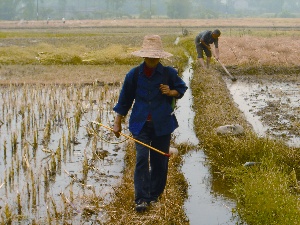Global Rice Output Rises on Demand in China, India
 Global rice production is slated to be 480 to 500 million tonnes (milled) for 2014-2015, according to FAO and USDA forecasts. While that global production is about .5% higher than last year, double-digit increases are expected throughout Asia and Africa as a result of increased planted area and better use of technology, including crop protection products.
Global rice production is slated to be 480 to 500 million tonnes (milled) for 2014-2015, according to FAO and USDA forecasts. While that global production is about .5% higher than last year, double-digit increases are expected throughout Asia and Africa as a result of increased planted area and better use of technology, including crop protection products.
Thailand is expected to reclaim its title as the largest rice exporter and China the largest importer in 2014.
China, India, Indonesia, Bangladesh and Vietnam produced the most rice in 2013-14, according to USDA. India, China, Indonesia, Bangladesh and Thailand had the greatest amount of planted rice area, while Egypt, Peru, Spain, South Korea, and China respectively produced the highest yields per hectare. Madagascar saw a remarkable 25% increase in production over last year (see this story online for links to full reports on global production).
Key Markets
China and India continue to look outward and increase their rice import and export activity. For these two key markets, the commodity has become more than an issue of domestic food security. According to the International Rice Research Institute (IRRI), China and India are now not only the world’s largest producers and consumers of rice – together making up half of all rice production in the world – they are also the world’s largest rice importers and exporters. India shot ahead of Thailand as the world’s largest rice exporter in recent years, the first time Thailand has been displaced in four decades. Similarly, China knocked Nigeria out of the top spot as rice importer. The IRRI speculates that these two markets are likely to continue to grow, though factors that stunt them include questionable data and statistics from China, and in India, weather conditions and pest problems.
For 2014, Chinese rice production is expected to increase 2% from 2013.
People are migrating away from rural Chinese farms, but farmers are not compensating for that by significantly investing in crop inputs because there is still sufficient available labor, according to a 2014 USDA study.
Researchers found that even though people are leaving their Chinese rice producing village households to work in urban areas, rice production is steady. There continues to be enough labor to go around, indicating that China could reach its goal of being able to produce a 9% increase in grain by 2020 that it will need to feed its exploding population.
India’s rice production is expected grow in the long term though a potential drought brought on by El Niño could pose challenges for rice production.
Planting conditions in June and July of 2014 mirrored those that preceded the drought of 2009, the worst in India’s recent history. More favorable rains developed in August and early September at presstime. Though India’s poor monsoon season is expected to result in a 2% drop in production, the government announced it will buy 30 million tonnes of rice from local farmers in the 12 months beginning in October, representing a 13% increase versus the previous year.
India has already achieved significant progress toward long-term food security through rice as a staple of most of the population. According to an Agriculture and Food Security study, better use of fertilizers, crop protection products and irrigation, environmental sustainability and varieties of rice that produce high yields have been emerging trends in Indian rice production in recent years.
In Nigeria, the government is offering support to rice growers by offering fertilizer discounted 50%, as well as 25 kg of improved seeds and discount-priced water pumps. USAID and its Japanese counterpart, JICA, will also partner with the government. JICA plans to provide inputs like better seeds as well as milling equipment, packaging technology and training, which could offset the projected production decrease in this country.
Emerging Markets
The USDA predicts that Guinea, Madagascar, Mali, Senegal and Tanzania will all be the major contributors to an Africa-wide increase in rice production to 13.1 million tons.
Africa is seeing an increase in quality and variety of rice seeds. Varieties developed by Stress-Tolerant Rice for Africa and South Asia (STRASA) can tolerate iron, salt and cold. In Tanzania, many of STRASA’s partner organizations are working to develop and distribute hybrid seeds tailored to local conditions.
Hybrids are also being tested in Latin America for their potential resistance to disease, heterosis and suitability for a tropical climate, perhaps presenting an opportunity to offset Brazil’s projected decreased rice yields in the near future. Paddy production in Brazil has steadily increased over the past four decades. Paddy acreage has decreased while yields have increased.
The USDA forecasts that South American exporters will experience an increase in rice production in the coming year, namely Argentina, Guyana, Paraguay and Uruguay.






